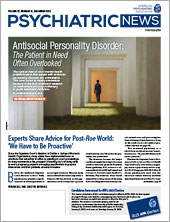How can psychiatry position itself for leadership in mental health care 10 or 20 years from now? And how can investing in measurement-based care—and in PsychPRO, APA’s qualified clinical registry that supports measurement-based care—help achieve that vision?
Those are two related strategic questions that APA’s Board of Trustees considered at its September meeting in Washington, D.C. In separate presentations, Robert Trestman, M.D., Ph.D., chair of APA’s Council on Healthcare Systems and Financing, and Robert Phillips, M.D., M.S.P.H., director of the Center for Professionalism and Value in Health Care of the American Board of Family Medicine, led the Board in “Learning and Vision” discussions about the future of psychiatry and APA.
Phillips presented information about the PRIME registry, the largest clinical registry for primary care clinicians. “PRIME is providing a lot of data for research collaborations with the CDC and NIH,” Phillips said. “Its goals are to reduce the burden of reporting and measurement collection, but it is also proving to be a laboratory for us for new high-value, quality measures and for developing tools to help clinicians know who they are serving and how they might work with their community resources to achieve better equity.”
For instance, PRIME has partnered with the Stanford Center for Population Health Services to derive data on COVID-19 cases and so-called “long COVID” and COVID vaccinations in primary care. Phillips also gave an overview of other projects of the Center for Professionalism and Value in Health that have yielded data on the geographic, racial, and ethnic diversity of the primary care workforce, rates of physician burnout and how burnout relates to quality and cost of care, and physician burden associated with electronic health records (EHRs). A collaboration between the center and the University of California, San Francisco, has revealed that 16% of family physicians are spending more than four hours a night on EHRs.
Challenged by APA President Rebecca Brendel, M.D., J.D., to advise APA on how it can think about using data and measurement-based care in a similar way, Phillips urged Board members to think in the long term.
“We didn’t build this overnight, and we are still building it to what we want to achieve,” Phillips said. “It’s probably a 10- to 20-year arc. I would think about the three big, audacious goals that you want to work toward and then think about what kind of data you are going to need to do that.”
Fundamentally, he said, “You need to understand your workforce and the viability of your workforce to address the array of things that need attention. And you need data on basic epidemiology—what is happening around certain aspects of care and how do those data inform policy-relevant questions.”
This includes understanding how psychiatrists relate to primary care and other partners in health care and “where the fractures are in those relationships.”
Phillips told Board members, “The schism between psychiatry and primary care is the deepest of any of the schisms, and we are not going to be able to fill our psychiatric deserts around the country unless we can break that down and create these relationships. So how do we do that? That is something that needs solving and that good data [can be used to help solve].”
“The opportunities for us are literally unending,” Trestman said. “We will never be out of work unless we choose to be so. In so many ways, so many things have come together now to make our job achievable. People today are openly talking about their histories of depression and anxiety, and mental health has become a part of the national discussion in a way it never has before. We have an opportunity that’s been presented to us to shape the conversation [about what mental health care will look like in the next decade].
“I don’t think in the year 2019 any of us thought we’d be delivering most of our care by video or audio, which is what we did for so much of our care delivery during the last three years,” Trestman said.
Making Anti-racism Part of APA’s DNA
Brendel led the Board through an update on the work of the
Structural Racism Accountability Committee (SRAC) and a discussion about how to embed equity and inclusion in everything that APA does. The APA website includes a SRAC landing page with a link to the “Action Progress Dashboard” that shows the status of all 18 of the recommendations of the Presidential Task Force on Structural Racism Throughout Psychiatry, established in 2020 by then APA President Jeffrey Geller, M.D., M.P.H.
“We have done a lot of work, and we still have a lot of work to do,” Brendel said. “The questions now are where do we go from here and how do we go forward in a way that puts this work in everything we are doing at every level of APA?”
As a platform for continuing the work of diversity and inclusion into the future, various proposals were offered, which Trustees later discussed. They voted to reconstitute the Structural Racism Accountability Committee with broader membership and staff support from the Membership Department and DDHE not only to advance its work at the leadership level of APA but also to promote extension to district branches and individual members.
Trustees agreed unanimously that engagement of membership at the district branch level has been a stumbling block, and the most crucial missing piece in embedding diversity and inclusion in the work of APA. “There is only so much we can do at the Board from the top down,” Brendel said.

